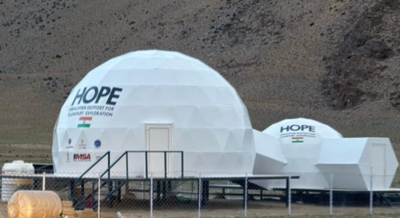ARTICLE AD BOX

Space missions help us explore the unknown, pushing the limits of human knowledge and technology. They prepare astronauts for the challenges of living and working beyond Earth, paving the way for exciting journeys to the Moon, Mars, and beyond.
Each mission brings us closer to new heights, but what if these missions are simulated on the Earth itself?
Two Indian astronauts complete 10-day Mars analog mission in Ladakh
Two Indian astronauts, Rahul Mogalapalli and Yaman Akot, recently completed a 10-day analog mission inside the Hope habitat located in the rugged Tso Kar region of Ladakh, about 150 km from Leh. The mission simulated the extreme conditions and routines astronauts would face during lunar and Martian exploration, providing a realistic and challenging training environment.Speaking to IndiaToday, Rahul described the experience as “a real learning curve.” He explained, “We had to ration food, water, and even internet bandwidth. Maintaining communication and staying disciplined was tough, but if given a chance, I’d do it again.” Both Rahul and Yaman also talked about the psychological challenges posed by extended isolation, emphasising the importance of such missions for India’s future space exploration plans.
What is the Hope mission?
The Hope mission, officially known as the Himalayan Outpost for Planetary Exploration (HOPE), is India’s first try at recreating what living in space might be like, right here on Earth. Created by Bengaluru-based Protoplanet in collaboration with ISRO’s Human Space Flight Centre (HSFC), it uses two habitat modules named Phobos and Deimos, after Mars’ moons, to copy the conditions astronauts would face on long space trips.Located in Ladakh’s harsh terrain, where temperatures swing significantly from 35°C to -25°C, the site gives conditions closely resembling those on Mars. The extreme weather and altitude make it an ideal location for testing the effects of isolation and limited resources.
Why is this mission important?
The data gathered during this mission is crucial for ISRO’s upcoming Gaganyaan mission, which aims to send Indian astronauts into space by 2027 and eventually to the Moon by 2040.
Rahul and Yaman conducted several biomedical experiments, including collecting urine, breath, and blood samples. These will be analyzed by ISRO scientists to understand the physiological, genetic, and psychological impacts of isolation and the harsh environment.According to India Today, Dr. Siddharth Pandey, founder and director of Protoplanet, highlighted the mission’s value not just for the astronauts but also for the entire team involved in preparing India’s space future.
He shared plans to expand the habitat to accommodate up to six analog astronauts and hopes that future Gaganyaan astronauts will take part in such simulations.According to the information from protoplanet and ISRO’s Human Space Flight Centre, following this successful mission, the Phobos and Deimos, simulator modules will function as automated weather stations, gathering data for upcoming missions. Protoplanet is already preparing for the next simulation, expected in April 2026.By successfully completing this analog mission, India takes a giant leap forward in preparing its astronauts for the challenges of space travel beyond Earth. The HOPE mission serves as a vital rehearsal, bringing the country closer to realizing its dream of establishing a human presence on the Moon and, eventually, Mars.



.png)
.png)
.png)
















 2 hours ago
3
2 hours ago
3









 English (US) ·
English (US) ·